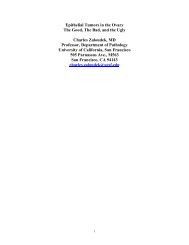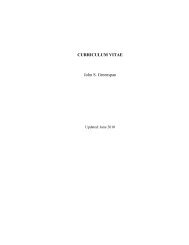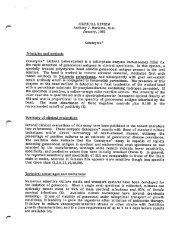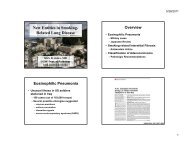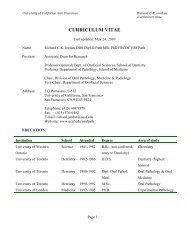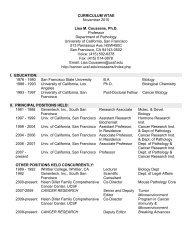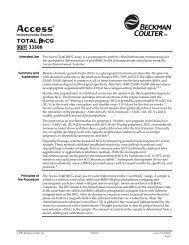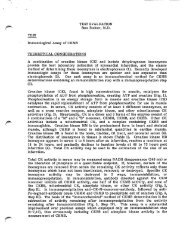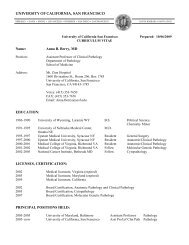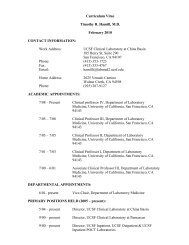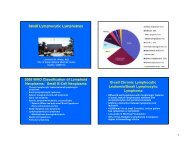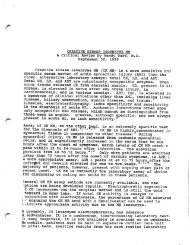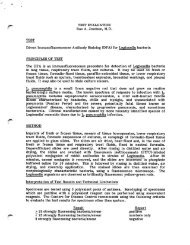25OH Vitamin D Total Assay - University of California, San Francisco
25OH Vitamin D Total Assay - University of California, San Francisco
25OH Vitamin D Total Assay - University of California, San Francisco
You also want an ePaper? Increase the reach of your titles
YUMPU automatically turns print PDFs into web optimized ePapers that Google loves.
UNIVERSITY OF CALIFORNIA SAN FRANCISCO, CLINICAL LABORATORIES<br />
Procedure Title: <strong>25OH</strong> <strong>Vitamin</strong> D <strong>Total</strong> <strong>Assay</strong> – DiaSorin LIAISON<br />
Document Section: CHEMISTRY Author: Kirk Sujishi, Linda Post Date Authored: NOVEMBER 2009<br />
Laboratory Director: TED KURTZ, MD (PARNASSUS & CHINA BASIN)<br />
Distribution: China Basin: CHEMISTRY<br />
In Use Date: December 7, 2009 Discontinued Date: ___________<br />
Revised By : ________________________ Reason:______________________________________Date: ____________<br />
Revised By : ________________________ Reason:______________________________________Date: ____________<br />
Revised By : ________________________ Reason:______________________________________Date: ____________<br />
Revised By : ________________________ Reason:______________________________________Date: ____________<br />
Revised By : ________________________ Reason:______________________________________Date: ____________<br />
Annual Director’s Approval (P/CB): ___________________________ Date: ________________<br />
Annual Director’s Approval (P/CB): ___________________________ Date: ________________<br />
Annual Director’s Approval (P/CB): ___________________________ Date_________________<br />
Annual Director’s Approval (P/CB): ___________________________ Date_________________<br />
Annual Director’s Approval (P/CB): ___________________________ Date_________________<br />
Annual Director’s Approval (P/CB): ___________________________ Date: ________________<br />
Annual Director’s Approval (P/CB): ___________________________ Date: ________________<br />
Annual Director’s Approval (P/CB): ___________________________ Date_________________<br />
Annual Director’s Approval (P/CB): ___________________________ Date_________________<br />
eterr:Library:Mail Downloads:<strong>25OH</strong>VitD<strong>Total</strong>.doc Page 1 <strong>of</strong> 15
I. PURPOSE<br />
UNIVERSITY OF CALIFORNIA SAN FRANCISCO, CLINICAL LABORATORIES<br />
The LIAISON 25 OH <strong>Vitamin</strong> D TOTAL <strong>Assay</strong> uses chemiluminescent immunoassay (CLIA)<br />
technology for the quantitative determination <strong>of</strong> 25-hydroxyvitiamin D and other hydroxylated vitamin<br />
D metabolites in human serum to be used in the assessment <strong>of</strong> vitamin D sufficiency. <strong>Assay</strong> results<br />
should be used in conjunction with other clinical or laboratory data to assist the clinician in making<br />
individual patient management decisions in an adult population.<br />
SUMMARY AND EXPLANATION OF TEST<br />
The role <strong>of</strong> vitamin D in bone and mineral metabolism was recognized from its first identification as a<br />
factor that could cure rickets. However, vitamin D is now recognized as a prohormone, which has<br />
multiple roles in maintaining optimal health.<br />
<strong>Vitamin</strong> D3 (cholecalciferol) and vitamin D2 (ergocalciferol) are the most abundant forms <strong>of</strong> vitamin D<br />
in the body. <strong>Vitamin</strong> D is synthesized in the skin from 7-dehydrocholesterol in response to sunlight.<br />
The best nutritional sources <strong>of</strong> D3 are oily fish, primarily salmon and mackerel. <strong>Vitamin</strong> D2‘s nutritional<br />
sources are some vegetables, yeast and fungi. The vegetarian diet is abundant in vitamin D2.<br />
<strong>Vitamin</strong> D (D3, D2 and metabolites) is converted to 25-hydroxyvitamin D in the liver. The<br />
measurement <strong>of</strong> 25-OH vitamin D concentration in the serum or plasma is the best indicator <strong>of</strong><br />
vitamin D nutritional status.<br />
The optimal level <strong>of</strong> 25-OH vitamin D is subject to some debate, but >32ng/mL (>80nmol/L) is<br />
accepted as sufficient for bone health. <strong>Vitamin</strong> D toxicity is a recognized problem, but a rare<br />
occurrence. Instead, a recent growing public health problem is vitamin D insufficiency. Several<br />
research studies have identified widespread vitamin D insufficiency in apparent healthy populations<br />
world-wide.<br />
<strong>Vitamin</strong> D deficiency is commonly treated with vitamin D2 or D3 medications in doses ranging from<br />
50,000 IU/month to 50,000 IU/week. Fortified foods and nutrition supplements may contain either<br />
form. To ensure accurate assessment <strong>of</strong> the total vitamin D all forms, including D3, D2 and<br />
metabolites, must be measured.<br />
Recent studies have identified an inactive 3-epimer <strong>of</strong> 25-OH vitamin D, which may be present in the<br />
serum <strong>of</strong> infants under the age <strong>of</strong> one year. Thus it is important that an assay avoid measuring the<br />
inactive 3-epi form and only measure the active D3 and D2 forms equally.<br />
BIOLOGICAL PRINCIPLES OF THE PROCEDURE<br />
The LIAISON 25 OH <strong>Vitamin</strong> D assay is a direct competitive chemiluminescence immunoassay<br />
(CLIA) for quantitative determination <strong>of</strong> total 25 OH vitamin D in serum. During the first incubation, 25<br />
OH vitamin D is dissociated from its binding protein and binds to the specific antibody on the solid<br />
phase. After 10 minutes, the tracer (vitamin D linked to an isoluminol derivative) is added. After a<br />
second 10 minute incubation, the unbound material is removed with a wash cycle. Subsequently, the<br />
starter reagents are added to initiate a flash chemiluminescent reaction. The light signal is measured<br />
by a photomultiplier as relative light units (RLU) and is inversely proportional to the concentration <strong>of</strong><br />
25 OH vitamin D present in calibrators, controls or samples.<br />
II. POLICY/SCOPE<br />
This procedure is intended for use by licensed CLS staff in the China Basin Chemistry section.<br />
III. TEST AVAILABILITY<br />
Test performed Monday, Wednesday and Fridays. Results will be available by 16:00.<br />
eterr:Library:Mail Downloads:<strong>25OH</strong>VitD<strong>Total</strong>.doc Page 2 <strong>of</strong> 15
IV. SPECIMEN REQUIRMENTS<br />
SPECIMEN TYPES<br />
UNIVERSITY OF CALIFORNIA SAN FRANCISCO, CLINICAL LABORATORIES<br />
1. Human serum or SST tubes.<br />
2. Fasting samples are recommended, but not required.<br />
3. Grossly hemolyzed or lipemic samples as well as samples containing particulate matter or<br />
exhibiting obvious microbial contamination should not be tested.<br />
4. The Diasorin LIAISON does not provide the capability to verify specimen type. It is the<br />
responsibility <strong>of</strong> the operator to verify that the correct specimen type is used in the <strong>25OH</strong> <strong>Vitamin</strong><br />
D TOTAL assay.<br />
PREPARATION FOR ANALYSIS<br />
STORAGE<br />
STABILITY<br />
1. The minimum volume required is 250 µL <strong>of</strong> specimen for the first test, and 25 µL more for each<br />
additional test.<br />
2. Mix thawed specimens thoroughly by low speed vortexing or by inverting 10 times. Visually<br />
inspect the specimens. If layering or stratification is observed, continue mixing until specimens<br />
are visibly homogeneous.<br />
3. Samples having particulate matter, turbidity, lipemia or erythrocyte debris may require clarification<br />
by filtration or centrifugation before testing. Check for and remove air bubbles before assaying.<br />
1. Frozen (-20˚C or below). Mix thawed samples well before testing.<br />
2. Specimens may be stored in glass or plastic vials. No additives or preservatives are required to<br />
maintain integrity <strong>of</strong> the samples.<br />
3. Avoid multiple freeze/thaw cycles. Samples should not be tested if exposed to more than three<br />
freeze/thaw cycles.<br />
After separation from cells:<br />
• Ambient: 3 days<br />
• Refrigerated: 1 week<br />
• Frozen: 6 months<br />
V. EQUIPMENT, REAGENTS AND SUPPLIES<br />
TEST INSTRUMENT: DiaSorin LIAISON System<br />
MATERIALS PROVIDED<br />
DiaSorin LIAISON Reagent Integral (Cat. No. 310600)<br />
MATERIALS REQUIRED BUT NOT PROVIDED<br />
1. DiaSorin LIAISON System (including sample racks).<br />
eterr:Library:Mail Downloads:<strong>25OH</strong>VitD<strong>Total</strong>.doc Page 3 <strong>of</strong> 15
REAGENTS<br />
UNIVERSITY OF CALIFORNIA SAN FRANCISCO, CLINICAL LABORATORIES<br />
2. LIAISON Module (Cat. No. 319130)<br />
3. LIAISON Starter Kit (Cat. No. 319102)<br />
4. LIAISON Light Check (Cat. No. 319101)<br />
5. LIAISON Wash/System Fluid (Cat No. 319100)<br />
6. LIAISON Waste Bags (Cat. No. 9450003)<br />
7. LIAISON 25 OH <strong>Vitamin</strong> D TOTAL Control Set (Cat. No. 310601)<br />
8. LIAISON 25 OH <strong>Vitamin</strong> D TOTAL Specimen Diluent (Cat. No. 310602)<br />
9. LIAISON 25 OH <strong>Vitamin</strong> D TOTAL Calibration Verifiers (Cat. No. 310603)<br />
10. LIAISON Cleaning Kit (Cat. No. 310990)<br />
11. LIAISON Xcelerator (Cat. No. A0090)<br />
12. Centrifuge (IEC Centra-7, International Equipment Company)<br />
13. 12 x 75 glass or plastic tubes<br />
14. Transfer pipettes<br />
15. Calibrated pipettes for delivering volumes <strong>of</strong> 75 µL and 225 µL<br />
16. For information on materials required for maintenance procedures, refer to the DiaSorin Liaison<br />
User Manual, Chapter 18.<br />
DIASORIN LIAISON REAGENT INTEGRAL, 100 TESTS, the following components are all contained<br />
within the Reagent Integral:<br />
1. Magnetic Particles (2.4 mL) Magnetic particles coated with antibody against 25 OH <strong>Vitamin</strong> D,<br />
protein, phosphate buffer, < 0.1% sodium azide.<br />
2. <strong>Assay</strong> Buffer (28.0 mL) Buffer with 10% ethanol, surfactants and preservatives.<br />
3. Conjugate (4.5 mL) 25 OH <strong>Vitamin</strong> D conjugated to an isoluminol derivative, in phosphate buffer<br />
with 10% ethanol, EDTA, surfactant and preservatives.<br />
4. Calibrator 1 (1.0 mL) Human serum, Tris Buffer, < 0.1% sodium azide and 25 OH <strong>Vitamin</strong> D.<br />
The calibrator concentrations (ng/mL) are referenced to standard preparations containing highly<br />
purified 25 OH <strong>Vitamin</strong> D.<br />
5. Calibrator 2 (1.0 mL) Human serum, Tris Buffer, < 0.1% sodium azide and 25 OH <strong>Vitamin</strong> D.<br />
The calibrator concentrations (ng/mL) are referenced to standard preparations containing highly<br />
purified 25 OH <strong>Vitamin</strong> D.<br />
OTHER REAGENTS<br />
1. LIAISON STARTERS<br />
eterr:Library:Mail Downloads:<strong>25OH</strong>VitD<strong>Total</strong>.doc Page 4 <strong>of</strong> 15
UNIVERSITY OF CALIFORNIA SAN FRANCISCO, CLINICAL LABORATORIES<br />
a. LIAISON STARTER 1: Catalyst in 4% NaOH<br />
b. LIAISON STARTER 2: 0.12% peroxide solution<br />
2. LIAISON WASH/SYSTEM LIQUID: Phosphate buffer solution (10x concentrate). Preservative:<br />
sodium azide.<br />
3. LIAISON LIGHT CHECK<br />
4. LIAISON 25 OH VITAMIN D TOTAL CONTROL SET (with Bar Code Labels for Controls 1 and 2)<br />
a. CONTROL LEVEL 1: Human serum with buffer salts and < 0.1% sodium azide as a<br />
preservative.<br />
b. CONTROL LEVEL 2: Human serum with buffer salts and < 0.1% sodium azide as a<br />
preservative.<br />
5. LIAISON 25 OH VITAMIN D TOTAL SPECIMEN DILUENT: Human serum with buffer salts and<br />
UNIVERSITY OF CALIFORNIA SAN FRANCISCO, CLINICAL LABORATORIES<br />
6. LIAISON 25 OH VITAMIN D TOTAL SPECIMEN DILUENT is stored at 2 – 8˚C upon receipt.<br />
When stored and handled as directed, the reagent is stable until the expiration date.<br />
7. LIAISON 25 OH VITAMIN D TOTAL CALIBRATION VERIFIERS are stored at 2 – 8˚C upon<br />
receipt. When stored and handled as directed, the reagent is stable until the expiration date.<br />
Once the vials are opened, the reagents are stable for 4 weeks when properly stored.<br />
INDICATIONS OF REAGENT DETERIORATION<br />
When a control value is out <strong>of</strong> the specified range, it may indicate deterioration <strong>of</strong> the reagents or<br />
errors in technique. Associated test results are invalid and samples must be retested. <strong>Assay</strong><br />
recalibration may be necessary.<br />
VI. WARNINGS AND PRECAUTIONS<br />
CAUTION<br />
For In Vitro Diagnostic Use.<br />
1. This product requires the handling <strong>of</strong> human specimens. It is recommended that all human<br />
sourced materials be considered potentially infectious and be handled in accordance with the<br />
OSHA Standard on Bloodborne Pathogens. Biosafety Level 2 or other appropriate biosafety<br />
practices should be used for materials.<br />
2. Some reagents used in this assay contain human source material and should be treated as<br />
potentially infectious. Each unit used in the preparation <strong>of</strong> this product has been tested by an<br />
FDA-approved method and found non-reactive for the presence <strong>of</strong> HBsAg, antibody to HCV and<br />
antibody to HIV1/2. While these methods are highly accurate, they do not guarantee that all<br />
infected units will be detected. This product may also contain other human source material for<br />
which there is no approved test. Because no known test method can <strong>of</strong>fer complete assurance<br />
that hepatitis B virus, hepatitis C virus (HCV), Human Immunodeficiency Virus (HIV) or other<br />
infectious agents are absent, all products containing human source material should be handled in<br />
accordance with good laboratory practices using appropriate precautions as described in the<br />
Centers for Disease Control and Prevention / National Institutes <strong>of</strong> Health Manual, “Biosafety in<br />
Microbiological and Biomedical Laboratories.” 4th ed., May 1999.<br />
3. Some reagents contain sodium azide as a preservative. Because sodium azide may form<br />
explosive lead azide or copper azide in plumbing, it is recommended that drains be thoroughly<br />
flushed with water after disposal <strong>of</strong> solutions containing sodium azide.<br />
4. For a detailed discussion <strong>of</strong> safety precautions during system operation, refer to the LIAISON<br />
User Manual.<br />
HANDLING PRECAUTIONS<br />
Do not use reagent kits beyond the expiration date.<br />
1. Contents <strong>of</strong> starter reagent bottles should never be pooled when replacing new containers with<br />
those in use, regardless <strong>of</strong> lot number.<br />
2. Before placing an integral on the instrument, suspend the magnetic particles in the first<br />
compartment by placing the integral in the Xcelerator for 30 seconds, then rotate the<br />
compartment for an additional minute. Check that all particles have been resuspended. Place<br />
the integral into the reagent bay and allow the instrument mixing to proceed for at least 30<br />
minutes prior to starting a test run.<br />
eterr:Library:Mail Downloads:<strong>25OH</strong>VitD<strong>Total</strong>.doc Page 6 <strong>of</strong> 15
UNIVERSITY OF CALIFORNIA SAN FRANCISCO, CLINICAL LABORATORIES<br />
3. Before loading an integral onto the instrument, check reagent compartments for bubbles and<br />
liquid adherence to the covers; remove if present.<br />
4. Newly prepared Wash/System Liquid must sit for 6 hours to de-gas prior to use on the instrument.<br />
5. Wash/System Liquid tanks must be bleached monthly according to manufacturer’s<br />
recommendations and rinsed thoroughly to prevent build up <strong>of</strong> residue from Wash/System Liquid,<br />
which could affect background readings. See maintenance procedures.<br />
VII. CALIBRATION / CALIBRATION VERIFICATION<br />
1. The predefined Master Curve is adjusted to a new instrument-specific curve using the two<br />
calibrators supplied in the Reagent Integral via the bar codes on the reagent integral label.<br />
2. Renewed calibration is required:<br />
a. With each new lot <strong>of</strong> reagents (Reagent Intergral or Starter Reagents).<br />
b. Every 7 days.<br />
c. After each servicing <strong>of</strong> the LIAISON Analyzer.<br />
d. If quality controls are out <strong>of</strong> acceptable range.<br />
3. Refer to the LIAISON Daily Quick Start Procedure for detailed information on how to perform an<br />
assay calibration.<br />
4. Refer to Appedix II for detailed information on how to perform a Calibration Verification.<br />
VIII. QUALITY CONTROL<br />
LIAISON 25 OH VITAMIN D TOTAL CONTROL SET (with Bar Code Labels for Controls 1 and 2)<br />
1. Controls are received in liquid form and require no further dilution prior to use.<br />
2. The controls are stored at 2 – 8˚C upon receipt. When stored and handled as directed, the<br />
reagent is stable until the expiration date.<br />
3. LIAISON 25 OH VITAMIN D TOTAL controls levels 1 and 2 are run each day <strong>of</strong> testing.<br />
IX. PROCEDURE<br />
ASSAY PROCEDURE<br />
For detailed instructions on the following steps, refer to LIAISON Daily Quick Start Procedure.<br />
For additional information on principles <strong>of</strong> operation, refer to the LIAISON User Manual.<br />
1. Prepare the Analyzer.<br />
a. Prepare Reagent Intergals.<br />
b. Check Instrument Status.<br />
c. Check Status <strong>of</strong> Data from Prior Run.<br />
d. Check Printer Status.<br />
2. Perform System Test.<br />
3. Perform Calibration if required.<br />
4. Run LIAISON 25 OH VITAMIN D TOTAL controls levels 1 and 2.<br />
5. Program, place and run patient samples.<br />
eterr:Library:Mail Downloads:<strong>25OH</strong>VitD<strong>Total</strong>.doc Page 7 <strong>of</strong> 15
UNIVERSITY OF CALIFORNIA SAN FRANCISCO, CLINICAL LABORATORIES<br />
6. Validate and print control and patient results.<br />
7. Save the database to the designated flash drive.<br />
8. Perform Daily Shut-Down procedure.<br />
9. For optimal performance, it is important to perform routine maintenance as described in the<br />
LIAISON User Manual. Detailed instructions may be found in the DisSorin LIAISON Maintenance<br />
procedure.<br />
SPECIMEN DILUTION PROCEDURES<br />
Specimens with a 25 OH <strong>Vitamin</strong> D <strong>Total</strong> result <strong>of</strong> >150 ng/mL will be flagged as “>>”. Samples<br />
should be diluted with LIAISON 25 OH <strong>Vitamin</strong> D TOTAL Specimen Diluent. Note that all lots <strong>of</strong><br />
specimen diluent are interchangeable between LIAISON 25 OH <strong>Vitamin</strong> D TOTAL <strong>Assay</strong> kit lots.<br />
Manual dilutions should be done as follows:<br />
a. A dilution <strong>of</strong> one part patient to 3 parts diluent is recommended, resulting in a 1:4 dilution.<br />
b. Mix specimen diluent thoroughly by gentle inversion prior to use.<br />
c. Add 75 µL <strong>of</strong> patient sample to 225 µL <strong>of</strong> specimen diluent.<br />
d. Mix well or vortex gently.<br />
X. RESULTING/REPORTABLE RANGE<br />
The predefined Master Curve is adjusted to a new instrument-specific curve using the two calibrators<br />
supplied in the reagent integral via the bar codes on the reagent integral label.<br />
Some results may contain information in the flags column <strong>of</strong> the report. For a description <strong>of</strong> the flags<br />
that may appear refer to the posted reference table or to the LIAISON Quick Guide Appendix, page<br />
25.<br />
ANALYTICAL MEASUREMENT RANGE & REPORTABLE RANGE<br />
The analytical measurement range for the DiaSorin LIAISON 25 OH <strong>Vitamin</strong> D <strong>Total</strong> <strong>Assay</strong> is 4<br />
ng/mL to 150 ng/mL.<br />
The lowest reportable value is 4 ng/mL, based on an inter-assay precision that approximates 20% CV<br />
(functional sensitivity). Values below 4 ng/mL should be reported as
XII LIMITATIONS OF PROCEDURE<br />
UNIVERSITY OF CALIFORNIA SAN FRANCISCO, CLINICAL LABORATORIES<br />
1. <strong>Assay</strong> results should be utilized in conjunction with other clinical and laboratory data to assist the<br />
clinician in making individual patient management decisions in an adult population.<br />
2. The antibody utilized in this assay will demonstrate cross reactivity to many dihydroxylated<br />
metabolites <strong>of</strong> vitamin D. However, in humans, these compounds are naturally present in<br />
picomolar concentrations.<br />
3. Bacterial contamination or repeated freeze-thaw cycles (>3) may affect the test results.<br />
4. A skillful technique and strict adherence to the instructions are necessary to obtain reliable<br />
results.<br />
5. The concentration <strong>of</strong> vitamin D in a given specimen determined with assays from different<br />
manufacturers may vary due to differences in methods and reagent specificity.<br />
XIII SPECIFICITY/INTERFERENCES<br />
SPECIFICITY<br />
Data on the cross-reactivity <strong>of</strong> the antiserum used in this assay were obtained by spiking up to 100<br />
ng/mL <strong>of</strong> the potential cross-reactant and assaying. The cross-reactivity <strong>of</strong> each compound,<br />
normalized to 25 OH <strong>Vitamin</strong> D3 is listed below.<br />
INTERFERENCE<br />
Steroid % Cross-reactivity<br />
25 OH <strong>Vitamin</strong> D2 104%<br />
25 OH <strong>Vitamin</strong> D3 100%<br />
<strong>Vitamin</strong> D2
Plasma<br />
METHOD COMPARISON<br />
TRUENESS<br />
UNIVERSITY OF CALIFORNIA SAN FRANCISCO, CLINICAL LABORATORIES<br />
Repeatability P1 P2 P3 P4<br />
Number <strong>of</strong> determinations 80 80 80 80<br />
Mean (ng/mL) 5.91 45.9 52.6 62.7<br />
Standard Deviation (ng/mL) 0.48 1.51 1.71 3.25<br />
Coefficient <strong>of</strong> Variation (%) 8.1 3.3 3.2 5.2<br />
Reproducibility P1 P2 P3 P4<br />
Number <strong>of</strong> determinations 80 80 80 80<br />
Mean (ng/mL) 5.91 45.9 52.6 62.7<br />
Standard Deviation (ng/mL) 0.75 3.19 3.65 4.92<br />
Coefficient <strong>of</strong> Variation (%) 12.7 6.9 6.9 7.9<br />
A total <strong>of</strong> 155 samples was tested by LIAISON 25 OH <strong>Vitamin</strong> D TOTAL and by DiaSorin 25 OH<br />
<strong>Vitamin</strong> D RIA. The resulting regression equation was:<br />
LIAISON = 0.99 (RIA) + 2.4; R = 0.97.<br />
The assay trueness has been verified by the dilution and recovery tests.<br />
1. Dilution Test:<br />
Five samples were diluted with LIAISON 25 OH <strong>Vitamin</strong> D TOTAL Specimen Diluent and<br />
analyzed. The results were analyzed as a linear regression <strong>of</strong> the Expected vs. Observed values.<br />
The resulting regression equation is: Observed = Expected 0.99 + 0.1; R = 0.99.<br />
2. Recovery Test<br />
High concentration samples were mixed with low concentration samples in ratios <strong>of</strong> 1:2, 1:1, and<br />
2:1. The observed values were then compared to the expected values to determine the %<br />
recovery. The mean recovery is 102%.<br />
Sample 1<br />
High neat<br />
2 H : 1 L<br />
1 H : 1 L<br />
1 H : 2 L<br />
Low neat<br />
Expected Concentration<br />
(ng/mL)<br />
35.1<br />
30.6<br />
26.0<br />
Observed Concentration<br />
(ng/mL)<br />
44.0<br />
34.1<br />
32.1<br />
25.7<br />
17.2<br />
% Recovery<br />
97%<br />
105%<br />
99%<br />
eterr:Library:Mail Downloads:<strong>25OH</strong>VitD<strong>Total</strong>.doc Page 10 <strong>of</strong> 15
Sample 2<br />
High neat<br />
2 H : 1 L<br />
1 H : 1 L<br />
1 H : 2 L<br />
Low neat<br />
Sample 3<br />
High neat<br />
2 H : 1 L<br />
1 H : 1 L<br />
1 H : 2 L<br />
Low neat<br />
Sample 4<br />
High neat<br />
2 H : 1 L<br />
1 H : 1 L<br />
1 H : 2 L<br />
Low neat<br />
Sample 5<br />
High neat<br />
2 H : 1 L<br />
1 H : 1 L<br />
1 H : 2 L<br />
Low neat<br />
UNIVERSITY OF CALIFORNIA SAN FRANCISCO, CLINICAL LABORATORIES<br />
74.9<br />
59.4<br />
43.9<br />
59.9<br />
48.9<br />
37.8<br />
93.2<br />
73.7<br />
54.2<br />
84.8<br />
64.8<br />
44.8<br />
XV ALTERNATE METHODS<br />
105.0<br />
76.0<br />
58.2<br />
45.6<br />
13.8<br />
81.4<br />
60.4<br />
48.2<br />
36.5<br />
16.3<br />
131.0<br />
92.7<br />
70.4<br />
53.9<br />
16.4<br />
123.6<br />
94.5<br />
68.9<br />
53.0<br />
6.0<br />
101%<br />
98%<br />
104%<br />
101%<br />
99%<br />
97%<br />
99%<br />
96%<br />
99%<br />
111%<br />
106%<br />
118%<br />
Mean Recovery 102%<br />
No backup method is available in the laboratory. Hold samples until instrument is back up. If delay is<br />
expected to be significant, consult with Supervisor or Director.<br />
XVI REFERENCES<br />
DiaSorin LIAISON 25 OH <strong>Vitamin</strong> D TOTAL <strong>Assay</strong> package insert<br />
DiaSorin LIAISON Starter package insert<br />
DiaSorin LIAISON Light Check package insert<br />
DiaSorin LIAISON Wash/System Liquid package insert<br />
DiaSorin LIAISON 25 OH <strong>Vitamin</strong> D TOTAL Control Set package insert<br />
DiaSorin LIAISON 25 OH <strong>Vitamin</strong> D TOTAL Specimen Diluent Set package insert<br />
DiaSorin LIAISON 25 OH <strong>Vitamin</strong> D TOTAL Calibration Verifiers package insert<br />
DiaSorin LIAISON Cleaning Kit package insert<br />
Holick MF, <strong>Vitamin</strong> D Status: Measurement, Interpretation, and Clinical Application, Annals <strong>of</strong><br />
Epidemiology, 2009 Feb; 19(2):73-8.<br />
Bisch<strong>of</strong>f-Ferrari HA et al., Estimation <strong>of</strong> optimal serum concentrations <strong>of</strong> 25-hydroxyvitamin D for<br />
multiple health outcomes, American Journal <strong>of</strong> Clinical Nutrition, 2006; 84:18-28.<br />
eterr:Library:Mail Downloads:<strong>25OH</strong>VitD<strong>Total</strong>.doc Page 11 <strong>of</strong> 15



